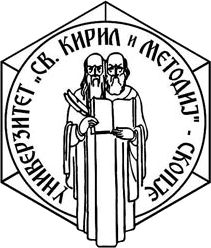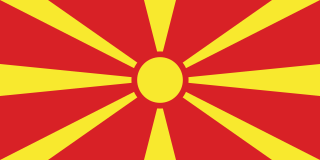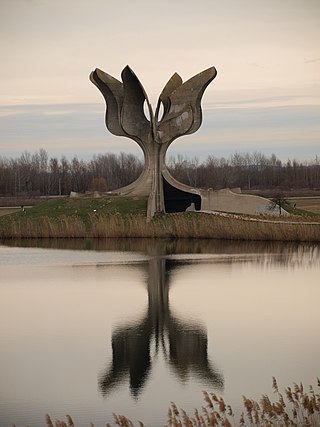
Skopje is the capital and largest city of North Macedonia. It is the country's political, cultural, economic, and academic centre. Skopje lies in the Skopje Basin.

Galičnik is a mountain village in North Macedonia and along with Lazaropole is one of the two biggest and oldest Mijak villages in the region. Galičnik has well-preserved traditional architecture, including an amphitheater in the village square, and is famous for its surrounding countryside and nature reserve.

The Saints Cyril and Methodius University is a public research university in Skopje, North Macedonia. It is the oldest and largest public university in the country. It is named after the Byzantine Christian theologians and missionaries Cyril and Methodius. As of 2018–19 school year, a total of 25,220 students are enrolled at the university. Furthermore, the teaching and research staff number 2,390 people; this is further supported by over 300 members in the university's institutions.

The League of Communists of Macedonia was the Macedonian branch of the ruling League of Communists of Yugoslavia during the period 1943 – 1990. It was formed on the basis of the Regional Committee of Communists in Macedonia under the name Communist Party of Macedonia during World War II in Yugoslav Macedonia. It retained that name until April 1952.

Nikola Kljusev was a Macedonian politician and professor of economics who served as the first Prime Minister of the Republic of Macedonia from March 20, 1991, to September 5, 1992, following the country's independence from Yugoslavia in 1991.

The 1963 Skopje earthquake was a 6.1 moment magnitude earthquake which occurred in Skopje, SR Macedonia, then part of the SFR Yugoslavia, on July 26, 1963, which killed over 1,070 people, injured between 3,000 and 4,000 and left more than 200,000 people homeless. About 80 percent of the city was destroyed.

Slavko Janevski was a Macedonian poet, prose and script writer. He was also active as a comics artist. He finished high school in Skopje. From 1945 onwards he was the editor of the first teenage magazine called "Pioneer". Janevski is the author of the first novel to be written in Macedonian, Seloto zad sedumte jaseni. As script writer he adapted the historical drama "Macedonian bloody wedding" in 1967. Janevski received many awards, among others "AVNOJ" 1968 and "Makedonsko slovo" for the book Thought. He is considered to have laid the foundations of the Macedonian literature.

The groups of people who have settled or controlled the territory of modern-day North Macedonia have influenced the country in many ways, one of the most visible being architecture. These groups of people include the Paionians, Illyrians, Ancient Macedonians, Romans, Byzantines, Bulgarians, Serbs, Ottomans, Yugoslavs, and ethnic Macedonians.

Mijaks are an ethnographic group of Macedonians who live in the Lower Reka region which is also known as Mijačija, along the Radika river, in western North Macedonia, numbering 30,000–60,000 people. The Mijaks practise predominantly animal husbandry, and are known for their ecclesiastical architecture, woodworking, iconography, and other rich traditions, as well as their characteristic Galičnik dialect of Macedonian. The main settlement of the Mijaks is Galičnik.

Ristiḱ Palace is a monumental symbolic building at Macedonia Square in Skopje, North Macedonia. The palace is located on the southern side of the Vardar river, in the southern part of Macedonia Square to the east is the birthplace of Mother Teresa, and to the south is the Memorial House of Mother Teresa and the headquarters of the Ministry of Transport and Communications of North Macedonia. It was built in 1926 and is currently used as an office block.
The national symbols of North Macedonia, as stated in the constitution, are the coat of arms, the flag and the anthem. After the independence of North Macedonia from Yugoslavia, the country made some changes in the national symbols. The flag was changed two times and today's flag includes an eight-ray sun on a red background, while the coat of arms from the Socialist Republic of Macedonia was retained, except the red star which was removed.

The national emblem of North Macedonia depicts two curved garlands of sheaves of wheat, tobacco leaves and opium poppy fruits, tied by a ribbon decorated with embroidery of traditional Macedonian folk motifs. In the center of the ovoid frame are depicted a mountain, a lake and a sunrise. The features of the national coat of arms contain a rising sun which symbolizes freedom, the Šar Mountains with its peak named Ljuboten or Mount Korab and the river Vardar, with Lake Ohrid. The emblem also contains opium poppy fruits; this poppy was brought to the area during Ottoman times in the first half of the 19th century. Until 16 November 2009, the emblem also depicted a socialistic five-pointed star in the top. This emblem had been in use since 1946, shortly after the republic became part of Yugoslavia.

Georgi Konstantinovski was a Macedonian architect, writer and educator. He graduated from the SS Cyril and Methodius University, Faculty of Architecture in Skopje in 1956 and received his Master of Architecture Degree from Yale University, under the mentorship of Paul Rudolph and Serge Chermayeff, in 1965. His early works are stylistically considered Brutalist. In New York City, he worked and collaborated with I. M. Pei, Henry Cobb Jr., and Araldo Cossutta.

The Transportation Center Skopje, or Skopje railway station (Macedonian: Транспортен центар Скопје Transporten centar Skopje, is the main central passenger railway station and bus terminal in the Republic of North Macedonia capital Skopje. It was built after the 1963 Skopje earthquake that destroyed the original station buildings, and much of the city. There are 10 tracks placed on a massive concrete bridge 2 kilometres long. The station is served by Long-distance trains to Belgrade, Thessaloniki, Athens and Ljubljana, and Express routes to Thessaloniki, via Vienna that serve Skopje twice daily, once going to Thessaloniki and second time returning to Vienna, passing through Belgrade and Ljubljana. The Skopje railway station is 15 min walking from the main square Makedonija.

The architecture of Yugoslavia was characterized by emerging, unique, and often differing national and regional narratives. As a socialist state remaining free from the Iron Curtain, Yugoslavia adopted a hybrid identity that combined the architectural, cultural, and political leanings of both Western liberal democracy and Soviet communism.
Tomislav Zografski was a Macedonian composer and music pedagogue who also wrote music for film and television. His neoclassical language played a key part in the journey of Macedonian music toward the postmodern era. Zografski's musical language was not archetypal of neoclassical folklore-inspired pastiche but instead more the result of him venturing into the examination and development of more exemplar traditional repertoire in a way that was unconventional and compelling and which retained transformed elements from an earlier period.
Elizabeta Dimitrova, is a Macedonian art historian, Byzantinist and professor.

The House of Slavko Brezovski is a historical house in Galičnik that is listed as Cultural heritage of North Macedonia. It is in ownership of one branch of the family of Brezoski.

Stokovna Kukja NaMa is a department store built in 1960, it represents an early example of modernist architecture in North Macedonia. The building is centrally located in Macedonia Square, Skopje in the very heart of the city centre of Skopje. The building is a work of High modernism. The buildings facade was damaged by the reconstruction for Skopje 2014. It was designed by architect Slavko Brezoski prior to the 1963 Skopje earthquake.

Plan for Skopje 1963 was the urban and architectural plan put forward to rebuild the city of Skopje following the 1963 Skopje earthquake. The plan was organised between 1963 and 1966 by the government of Yugoslavia and the United Nations. The rebuilding of the city attracted large international attention, this led to the involvement of a large number of high-profile architects. The UN invited Kenzo Tange and his team to participate in an international competition for the urban design of the city centre in 1965; as one of several Yugoslav and international architecture teams. Architects that participated in the plan include Greek architect Constantinos Doxiadis and Polish architect Adolf Ciborowski. Dutch architects Van den Broek and Jaap Bakema. Luigi Piccinato (Italy) and Maurice Rotival (USA). Yugoslav participants included Aleksandar Dordevik, Slavko Brezoski, Edvard Ravnikar, Radovan Miščević and Fedor Wenzler.



























